What is Jalapeño pepper, how is it grown and used?
Jalapeño - what is it? A wonderful name for a vegetable, isn't it? This pepper has been in space as the favorite seasoning of American astronauts. Almost every Mexican dish uses Jalapeño. Spicy lovers in our country are familiar with this pepper.
How to grow, where to use, photos and many other interesting things about Jalapeño peppers can be found in our article.
What kind of pepper is this
Jalapeño is a variety of vegetable pepper (lat. Capsicum annuum). It got its name from the Mexican city of Xalapa, where it is mainly grown.
What it looks like, how and where it grows
Jalapeño pepper is a bushy plant up to 1 m high with branched stems, elliptical leaves and white to grayish flowers. The fruits are small, from 5 to 9 cm in length; 25-35 even, conical-shaped peppers with thick, juicy walls are collected from one plant per season.
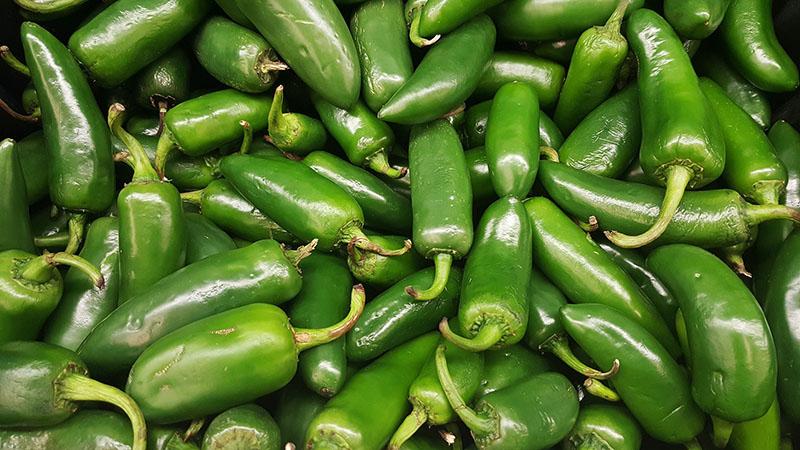
Technically ripe green fruits are valued; Peppers that are overripe and have a red color are not used; in extreme cases, they are dried or smoked.
The most extensive plantations of the crop are located in Mexico. This pepper is also widespread in the southern states of the USA: New Mexico and Texas.
This is a heat-loving plant, so in Russia amateurs grow it in greenhouses and on window sills.
Taste and aroma, spiciness
Jalapeño has a characteristic sour taste. The degree of pungency, depending on the conditions and place of growth, varies from strong to hot. On the Scoville scale it ranges from 2500-8000 units.For comparison, sweet bell pepper - 0 units, red hot pepper (chili pepper) - from 30,000 to 50,000 units.
The sharpest parts of the fruit (due to the high content of capsaicin) are the seeds and the inner membrane. After removing them, the pepper's spiciness decreases.
Peculiarities
Jalapeño peppers are valued for their high content of nutrients. It adds moderate heat and piquancy to various meat, vegetable dishes and sauces. Eating this type of pepper causes an unusual sensation of warmth, followed by an increase in pungent taste in the mouth.
Composition, properties, KBJU
Jalapeño contains a large amount of essential oils, vitamins E, A, C, and group B.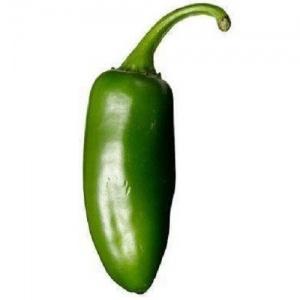
It contains carotenoids, trace elements sodium, calcium, magnesium. Due to the relatively low content of capsaicin, it does not have a pronounced burning taste: if you try the pepper, the burning sensation on the tongue will quickly pass.
In terms of 100 g of product, caloric content is 30 kcal, protein content is 1.35 g, fat is 0.62 g, carbohydrates are 5.91 g.
Harm and benefit
Jalapeño peppers have many beneficial properties.
The substance capsaicin, which causes a burning taste, thins the blood and helps normalize blood pressure.
This product has a positive effect on metabolic processes and helps digest heavy protein foods. Eating pepper produces endorphins, improves mood, and normalizes sleep. Jalapeño strengthens the immune system; regular use in food improves the condition of the skin and hair.
However, if you consume this type of pepper in large quantities, can damage the gastric mucosa.
Contraindications
People with individual intolerance, kidney, liver, and gastrointestinal tract diseases should not eat Jalapeño peppers.The consumption of spicy foods is contraindicated for children, pregnant and lactating women.
Jalapeño Pepper Varieties
There are several varieties, differing in degree of severity and region of growth:
- Espinalteco has pointed pods.
- Morita - the most famous Jalapeño pepper in our country with short rounded fruits.
- Peludo – fleshy long peppers.
Application
Cooking is the main use of Jalapeños. But the burning components contained in the fruits make it possible to use it in medicine and cosmetology.
In cooking
There probably isn't a Mexican dish that doesn't have Jalapeño in its recipe. It is added to salads, vegetable and meat dishes, and soups. Fresh peppers are used in tomato-based condiments and sauces.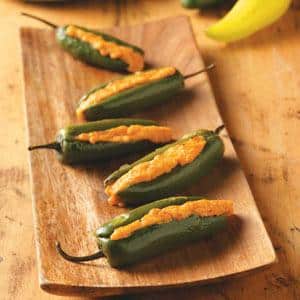
A feast for a gourmet - stuffed Jalapenos. For example, pepper pods are stuffed with grated cheese and decorated with rings of the same spicy fruit.
In European countries, pickled peppers are used. They are added to main courses, soups, and pizza.
The popular soft drink sangrita also contains this green hot pepper.
In addition, dishes with the addition of Jalapeño remain fresh longer.
In folk medicine
Tinctures that improve appetite are prepared from Jalapeño peppers. They are also recommended for use for insomnia.
In cosmetology
Thanks to vitamins and substances that improve blood circulation in the skin, Jalapeño is considered an excellent ingredient in anti-hair loss masks and anti-cellulite products. Having antibacterial properties, baths with this pepper reduce sweating of the feet.
Attention! The use of cosmetics containing Jalapeño is not recommended for people with hypersensitive skin.If there are wounds or cracks, you should also wait a little while using such products.
Growing
A stranger with a sharp character is not whimsical; it is quite possible to grow him on a personal plot or windowsill. The agricultural technology for growing Jalapeño is no different from that used for the usual sweet pepper. At home it is grown as a perennial.
Features of care
Landing produced using seeds. It is better to buy them in specialized gardening stores. Before planting, the seeds must be pickled in a one percent solution of potassium permanganate for 20-30 minutes. Germinate the seeds on moistened gauze for 24-48 hours, avoiding drying out.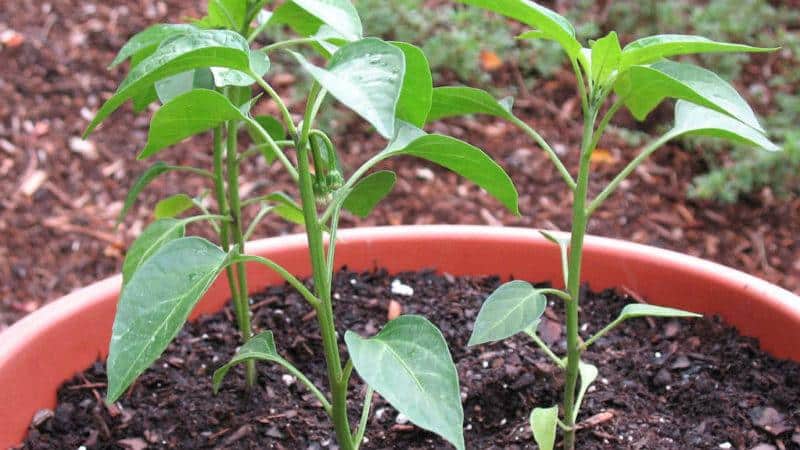
Planting both for seedlings and for cultivation at home is carried out in March-April.
To grow Jalapenos, use loose, nutritious soil with good drainage. Ready-made soil for flower or vegetable crops is ideal. Seeds should be planted to a depth of 1-1.5 cm; if planted deeper, they may not germinate.
Seedlings grow in 45-75 days. Jalapeño is heat-loving and afraid of cold and drafts, so boxes with seedlings are covered with film until shoots emerge. Then the film is opened briefly at first and the ventilation time is gradually increased. After several days of hardening, the film is completely removed. It is necessary to water the seedlings moderately but regularly. The first feeding is carried out 10 days after emergence.
When the plant acquires 2-3 pairs of true leaves, it is transplanted to a permanent location. To do this, take a plastic or ceramic pot with a volume of at least 5 liters. The soil used is the same as for planting seeds.
To grow peppers in your personal plot, it is better to organize a greenhouse.Seedlings are planted in the ground in late May - early June.
When the sprouts reach a height of 15-20 cm, they are pinched so that the bush branches.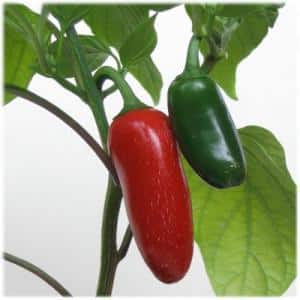
Flowering and fruit formation occurs throughout the summer.
Watering is carried out as the soil dries, but at least 2-3 times a week with settled warm water.
For growth and fruiting, Jalapeño requires microelements: nitrogen, phosphorus, potassium. Fertilizing is carried out at least once every two weeks with complex fertilizers - superphosphate and potassium humate. They should be used according to the instructions.
The most comfortable conditions for the plant are at an air temperature of 24-28ºС, in a bright, draft-free place.
Caring for a plant in winter at home has its own characteristics. After flowering and fruiting begins a period of rest. Bushes slow down or stop growing, partially or completely shed their leaves. At this time, the pots with pepper are moved to a cool place with a temperature of 12-18ºС, fertilizing is stopped, watering is reduced to once a week.
In the spring, with the end of the dormant period, the plants are returned to a warm place and fertilizing and watering are resumed.
Diseases and pests
Jalapeño peppers are most commonly susceptible to blackleg and blossom end rot. Blackleg attacks seedlings. The stems become thinner and the leaves fade. The disease occurs when overwatering or using cold water. With blossom end rot, the fruits become covered with black spots. Causes of the pathogenic process: lack of calcium, excess nitrogen and insufficient watering.
It is a mistake to believe that hot pepper varieties are not susceptible to pest attacks. Aphids, whiteflies, and spider mites are found on Jalapeño bushes.

To get rid of them, insecticides or folk remedies are used:
- An effective remedy against aphids and whiteflies - infusion of garlic and dandelion. To prepare it, take one tablespoon of chopped garlic and dandelion stems, add water and leave for a day, filter and spray the bushes.
- To combat spider mites, use a solution of ammonia and laundry soap. For 1 liter of water, take 1 tablespoon of ammonia and a spoonful of grated soap, stir thoroughly and treat the plants, covering the soil so that the solution does not get on it.
Collection and storage
The bushes bear fruit throughout the summer. Green peppers 5-6 cm long are collected. Over the course of several weeks, the fruits turn red, become sweeter, and their pungency decreases.
Important! When collecting and laying, use gloves, as plant sap causes skin irritation.
Fresh pods stored in jars in the refrigerator or cellar for no more than 14 days, and dried Jalapeno - in an airtight glass container in a dark place. Suitable for long-term storage pickled peppers.
Making spices
To make spices, Jalapeños are dried and, if necessary, crushed.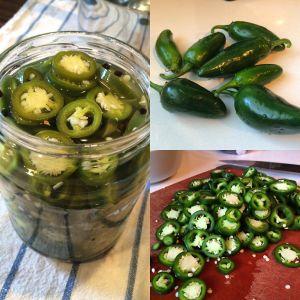
Pickled hot peppers are an excellent seasoning for various dishes. A classic marinade of wine vinegar, sugar and salt preserves the natural flavor of the pepper.
For 15 Jalapeño pods, prepare a marinade with the following proportions:
- 240 ml white wine vinegar;
- 240 ml water;
- 4 tbsp. l. Sahara;
- 2 tbsp. l. salt.
Conclusion
Jalapeño is a medium-hot variety of vegetable pepper, a traditional component of Mexican cuisine. It is most widely cultivated in Mexico, as well as in the southern United States. Suitable for those who want to diversify their food with something spicy, but are not ready for too “hot” experiments.
There are three varieties of Jalapeño: the pointed espinalteco, the fleshy elongated peludo, and the more famous in Russia morita with short round fruits. This type of pepper is successfully grown in the central zone of our country in dachas, as well as at home as a perennial plant. Care consists of regular moderate watering and fertilizing.
Jalapeño is eaten fresh, dried and pickled. It also finds application in medicine and cosmetology.